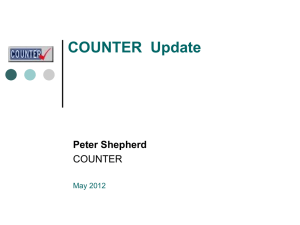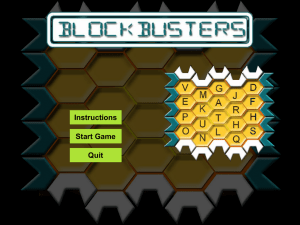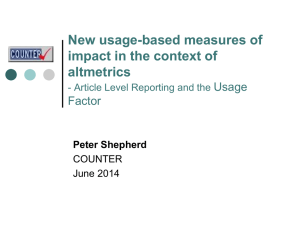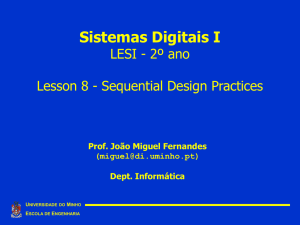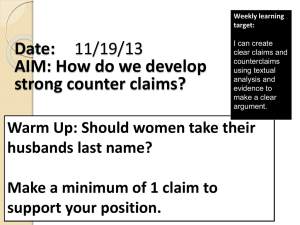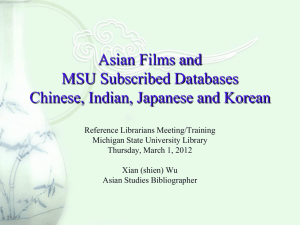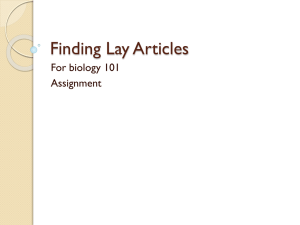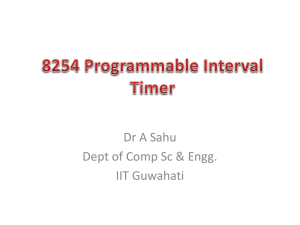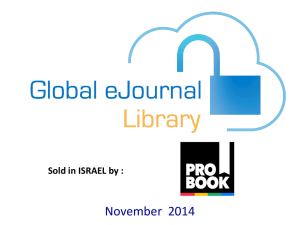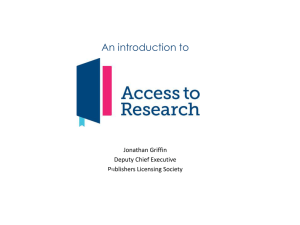NISO Webinar
advertisement
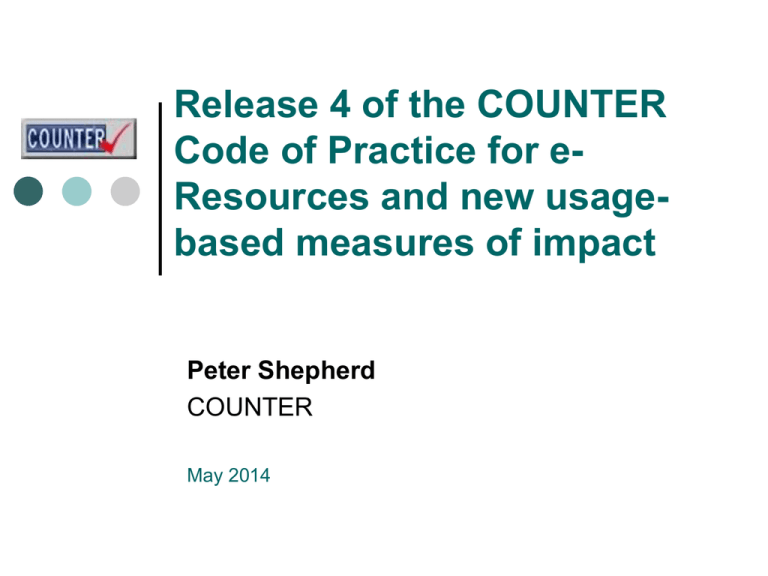
Release 4 of the COUNTER Code of Practice for eResources and new usagebased measures of impact Peter Shepherd COUNTER May 2014 COUNTER Release 4 - objectives A single, unified Code covering all e-resources, including journals, databases, books, reference works, multimedia content, etc. Improve the database reports Improve the reporting of archive usage Enable the reporting of mobile usage separately Expand the categories of ‘Access Denied’ covered Improve the application of XML and SUSHI in the design of the usage reports Collect metadata that facilitates the linking of usage statistics to other datasets, such as subscription information Release 4: main features A single, integrated Code of Practice covering journals, databases, books, reference works and multimedia content An expanded list of Definitions, including terms such as ‘Gold Open Access’, ‘Multimedia Full Content Unit’, ‘Record View’, ‘Result Click’, as well as different categories of ‘Access Denied’, etc. that are used for the first time in Release 4 Enhancements of the SUSHI (Standardised Usage Statistics Harvesting Initiative) protocol designed to facilitate its implementation by vendors and its use by librarians Release 4: main features A requirement that Institutional Identifiers, Journal DOI and Book DOI be included in the usage reports, to facilitate not only the management of usage data, but also the linking of usage data to other data relevant to collections of online content. A requirement that usage of Gold Open Access articles within journals be reported separately in a new report: Journal Report 1 GOA: Number of Successful Gold Open Access Full-text Article Requests by Month and Journal. A requirement that Journal Report 5 must be provided Release 4: main features Modified Database Reports, in which the previous requirement to report Session counts has been dropped, and new requirements, to report Record Views and Result Clicks, have been added. (Database Report 3 has also been renamed Platform Report 1). A new report, Multimedia Report 1, which covers the usage of nontextual multimedia resources, such as audio, video and images, by reporting the number of successful requests for multimedia full content units New optional reports covering usage on mobile devices A description of the relative advantages of logfiles and page tags as the basis for counting online usage Flexibility in the usage reporting period that allows customers to specify a date range for their usage reports Release 4: Standard Usage Reports Journal Report 1: Number of Successful Full-Text Article Requests by Month and Journal Journal Report 1 GOA: Number of Successful Gold Open Access Full-Text Article Requests by Month and Journal Journal Report 2: Access Denied to Full-Text Articles by Month, Journal and Category Journal Report 5: Number of Successful Full-Text Article Requests by Year-ofPublication (YOP) and Journal Database Report 1: Total Searches, Result Clicks and Record Views by Month and Database Database Report 2: Access Denied by Month, Database and Category Platform Report 1: Total Searches, Result Clicks and Record Views by Month and Platform Book Report 1: Number of Successful Requests by Month and Title Book Report 2: Number of Successful Section Requests by Month and Title Book Report 3: Access Denied to Content Items by Month, Title and Category Book Report 4: Access Denied to Content Items by Month, Platform and Category Book Report 5: Total Searches by Month and Title Multimedia Report 1: Number of Successful Full Multimedia Content Units Requests by Month and Collection Release 4: recording and reporting usage on mobile devices The following optional additional reports enable usage on mobile devices to be reported separately: Journal Report 3 Mobile: Number of Successful Item Requests by Month, Journal and Page Type for usage on a Mobile Device Title Report 1 Mobile: Number of Successful Requests for Journal Full-text Articles and Book Sections by Month and Title ( formatted for normal browsers/delivered to mobile devices AND formatted for mobile devices/delivered to mobile devices) Title Report 3 Mobile: Number of Successful Requests by Month, Title and Page Type (formatted for normal browsers/delivered to mobile devices AND formatted for mobile devices/delivered to mobile devices) COUNTER will recognize as usage on a mobile device, which may be reported in the above reports, any usage that meets one of the following criteria: useragents that are included in the WURFL list. WURFL is the Wireless Universal Resource FiLe, a database containing the profile of mobile devices; this database may be found at: http://wurfl.sourceforge.net/ usage via a proprietary mobile App provided by the publisher/content provider Release 4: timetable for implementation Deadline date for implementation of Release 4: 31 December 2013 -after this date only vendors compliant with Release 4 are COUNTER compliant Over 100 Publishers/Vendors are now providing Release 4 Usage Reports COUNTER Code of Practice -Release 4 Full details of Release 4 will be found on the COUNTER website at: http://www.projectcounter.org/code_practice.html New COUNTER usage-based measures of impact Advantages: Usage can be reported at the individual item and individual researcher level Usage is more ’immediate’ than citations Usage potentially covers all categories of online publication COUNTER usage statistics are independently audited and generally trusted Two new COUNTER Codes of Practice have been launched: COUNTER Code of Practice for Articles (COUNTER Articles) Recording, consolidation and reporting of usage at the individual article level Standard applies to publishers, aggregators and repositories COUNTER Code of Practice for Usage Factor Usage-based measure of impact of journals, institutions and individual scholars The Usage Factor for a Journal is the Median Value in a set of ordered full-text article usage data ( i.e. the number of successful full text article requests) for a specified Usage Period of articles published in a journal during a specified Publication Period. COUNTER Articles and Usage Factor are both based on the recording and consolidation of COUNTER-compliant usage data at the individual article level COUNTER Code of Practice for Articles COUNTER Articles covers the following areas: article types to be counted; article versions to be counted; data elements to be measured; definitions of these data elements; content and format of usage reports; requirements for data collection and data processing; requirements for independent audit (under development); Release 1 of the COUNTER Code of Practice for Articles is available on the COUNTER website at: http://www.projectcounter.org/counterarticles.html Usage Factor: aims and outcomes The overall aim of the Usage Factor project was to explore how online journal usage statistics might form the basis of a new measure of journal impact and quality, the Usage Factor for journals. Specific objectives were to answer the following questions: Will Usage Factor be a statistically meaningful measure? Will Usage Factor be accepted by researchers, publishers, librarians and research institutions? Will Usage Factor be statistically credible and robust? Is there an organizational and economic model for its implementation that would cost-effective and be acceptable to the major stakeholder groups. Following extensive testing using usage data for over 200 journals from a range of publishers the main outcome of the project has been the new COUNTER Code of Practice for Usage Factors. This new Code of Practice uses the article level usage data collected using the COUNTER Code of Practice for Articles as the basis for the calculation of the Usage Factor. The COUNTER Code of Practice for Usage Factors is available on the COUNTER website at: http://www.projectcounter.org/usage_factor.html Who will benefit from the Usage Factor? Four major groups will benefit from the introduction of Usage Factors: Authors, especially those in practitioner-oriented fields, where citationbased measures understate the impact of journals, as well as those in areas outside the core STM fields of pure research, where coverage of journals by citation-based measures is weak. Publishers, especially those with large numbers of journals outside of the core STM research areas, where there is no reliable, universal measure of journal impact, because citation-based measures are either inadequate or non-existent for these fields Librarians, when deciding on new journal acquisitions, have no reliable, global measures of journal impact for fields outside the core STM research fields. They would use usage-based measures to help them prioritise journals to be added to their collections. Research Funding Agencies, who are seeking a wider range of credible, consistent quantitative measures of the value and impact of the outputs of the research that they fund. Usage Factor: Journals - the calculation Publishers will be able to generate Usage Factors using the Code of Practice, but will have to be independently audited for their Usage Factors to be listed in the Usage Factor Central Registry. Two categories of Usage Factor may be calculated The 24 month Journal Usage Factor 2010/2011: all content The median number of successful requests during 2010/2011 to content published in the journal in 2010/2011 The Journal Usage Factor 2010/2011: full-text articles only The median number of successful requests during 2010/2011 to full-text articles published in the journal in 2010/2011 Note: 1.The article-level data collected in COUNTER Article Report 1 will be used as the basis for the Usage Factor calculation 2. Usage Factors will be reported annually, for 2010/2011, 2011/2012, etc. COUNTER Articles and Usage Factor - implementation Step 1: implement COUNTER Code of Practice for Articles Step 2: Collect article-level usage data for 2014/2015 Step 3: Calculate and report Usage Factors using protocols specified in Code of Practice for Usage Factors
